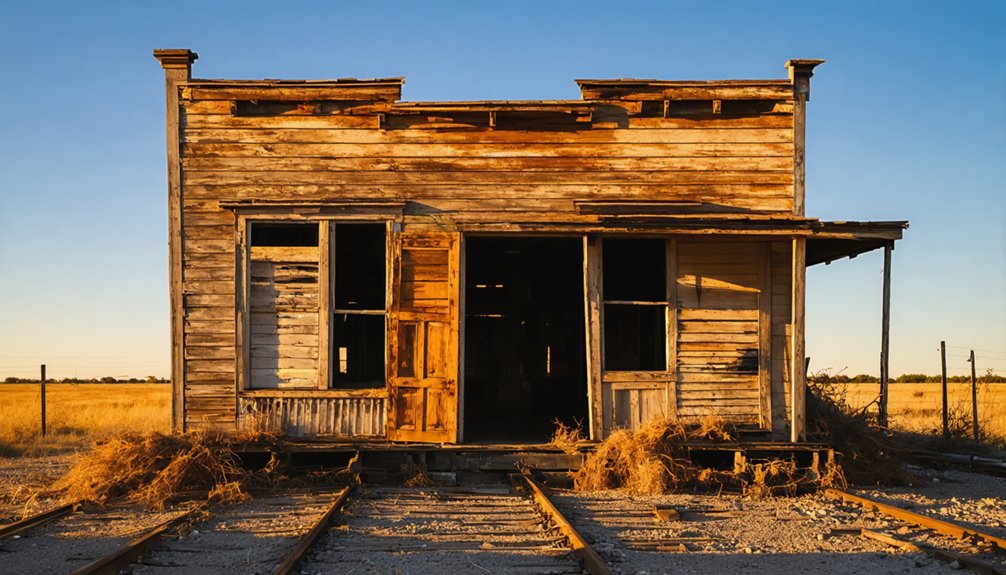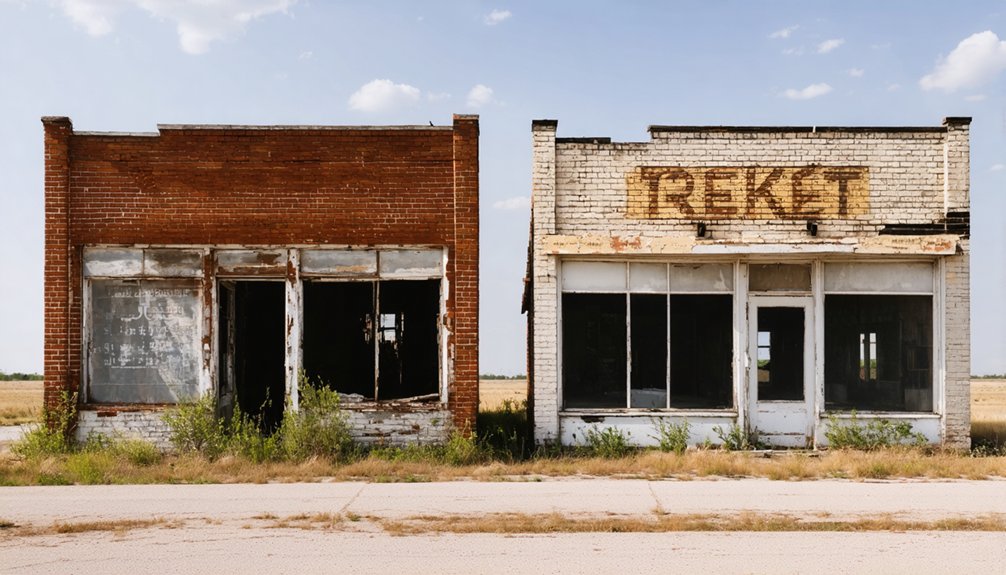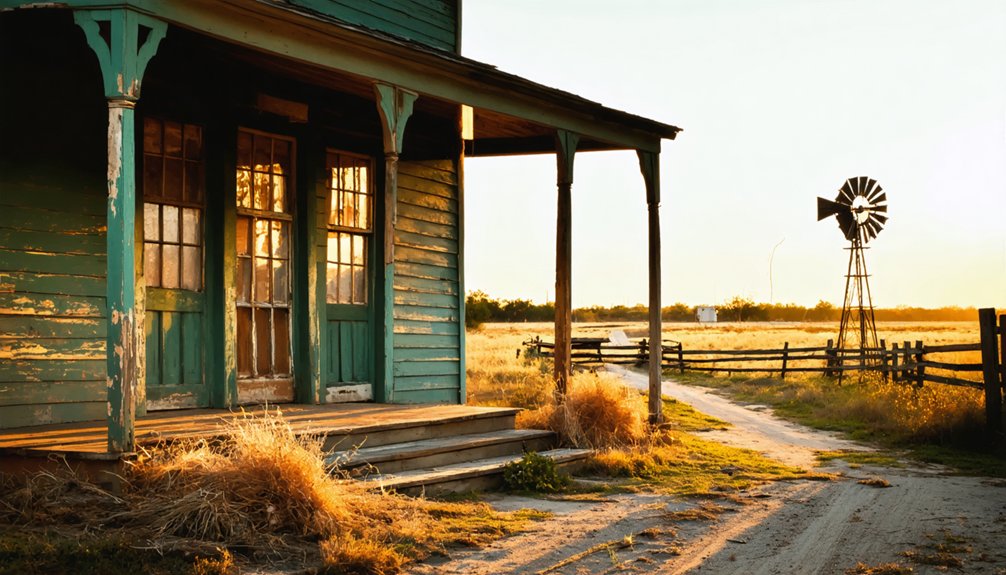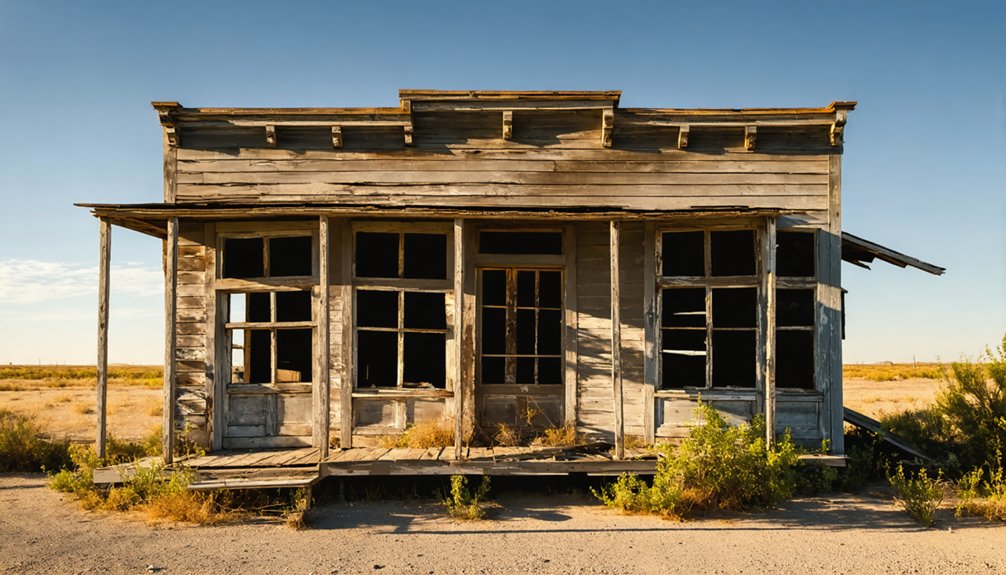You’ll find Girvin, Texas along US 67 near the Pecos River, where it first emerged as Granada in 1898. The town flourished after 1912 when the Kansas City, Mexico and Orient Railway made it a major cattle shipping hub, complete with holding pens, a post office, and stores. Today, you can explore two distinct sites: Old Girvin’s weathered structures and New Girvin’s relocated railroad depot – each telling pieces of this once-bustling frontier town’s story.
Key Takeaways
- Girvin, Texas transformed from a bustling cattle shipping point in 1912 to a ghost town after the railroad bypassed it in 1933.
- The town consists of two areas: Old Girvin with weathered wooden structures, and New Girvin near the US 67 intersection.
- Abandoned buildings include the roofless Helmers’ store, empty Social Club bar, and various deteriorating Western-style facades.
- The 1930s schoolhouse remains standing and serves as a voting precinct and gathering place for annual community reunions.
- Originally named Granada in 1898, Girvin thrived as a major livestock shipping hub before declining into a ghost town.
The Birth of a Railroad Town

When the Kansas City, Mexico and Orient Railway reached northeastern Pecos County in 1912, it established Girvin as an indispensable cattle shipping point along its route from Mertzon. The railroad expansion positioned Girvin strategically near the Pecos River, creating a crucial transportation hub that connected the region’s cattle trade to larger Texas markets.
You’ll find Girvin’s early development centered entirely around serving the railway workers and bustling cattle industry. Much like the racehorse that would later share its name, this town commanded a price of $130,000 during its peak trading period.
The town’s namesake, local rancher John H. Girvin, played a significant role in shaping the area’s ranching operations. As the settlement grew, it attracted important businesses to support the increasing traffic of workers and travelers. The establishment of a post office and school soon followed, transforming what began as a simple train stop into a thriving community. The town quickly expanded to include a general store and hotel, serving the needs of both residents and visitors.
From Granada to Girvin: A Name’s Legacy
Before becoming known as Girvin, this remote Texas settlement began its story as Granada in 1898, when rancher John F. Weatherly established his family’s dugout near the Pecos River.
The name significance of Granada runs deep, echoing the legacy of Spain’s historic Moorish kingdom and carrying rich cultural connections to both Latin and Arabic roots.
Granada’s name weaves together centuries of Moorish influence in Spain, bridging Latin and Arabic cultural traditions.
You’ll find fascinating layers of meaning in the original Granada name, from its ties to pomegranates (Latin granatum) to the poetic “hill of strangers” (Moorish karnattah). Granada’s magic and history are particularly evident in its legendary sunset views. The area’s ancient roots stretch remarkably far, with Bronze Age artifacts discovered in the region dating back to at least 5500 BC.
While the specific reasons for Weatherly’s decision to rename the town Girvin aren’t fully documented, the change likely stemmed from practical needs to avoid confusion with other settlements and establish a unique identity for this budding railroad community in Pecos County.
The Golden Era of Cattle and Commerce
During its heyday, Girvin emerged as one of Texas’s most significant livestock shipping hubs along the Kansas City, Mexico and Orient Railway. You’d find more livestock cars moving through Girvin’s tracks to Kansas than any other point, showcasing its dominance in cattle shipping commerce. The Chisholm Trail route established in 1867 had already paved the way for efficient cattle transportation to northern markets.
The town’s massive holding pens, spanning one and a half sections, enabled efficient handling of large herds bound for market. By 1900, 142,764 sheep occupied Pecos County, making sheep a major contributor to Girvin’s livestock operations.
- Texas longhorns thundered through the open ranges, managed by cowboys on horseback
- Ranchers drove their cattle south to New Orleans and north along the Shawnee Trail
- Sheep ranchers joined the mix, shipping wool and flocks through Girvin’s facilities
This golden era of livestock commerce wouldn’t last forever – when the railroad bypassed Girvin in 1933, the town’s prosperous days began to fade.
Life Along the Pecos River
You’ll find the earliest ranching settlements near Girvin clustered along the Pecos River‘s edge, where pioneer families carved out homesteads despite the challenging access to the river’s salty waters.
The river’s diverse terrain of deserts and plains attracted Spanish explorers seeking riches in the 16th century. Ranch operations depended heavily on the Pecos, though its deep gorge and high banks made water access difficult except at established crossing points like Horsehead Crossing. This challenging topography was typical of the region, which featured deep canyons throughout the lower Pecos area.
The river’s unpredictable nature, shifting from dangerous floods to barely flowing streams, forced ranchers to develop elaborate water management systems including earthen tanks and eventually irrigation networks from the Red Bluff Reservoir.
Early Settlement Patterns
Along the banks of the Pecos River, indigenous settlement patterns emerged as early as A.D. 800 when Pecos Pueblo Indians established thriving communities.
At its peak in 1540, Pecos Pueblo housed 2,000 inhabitants and featured a Spanish mission, though raids and colonial pressures led to its abandonment by 1838. Spanish explorer Francisco Vazquez de Coronado made the first crossing of the river in 1541.
You’ll find the region’s settlement history shaped by these key patterns:
- Villages clustered around strategic water crossings and fords, like Horsehead Crossing
- Complex irrigation systems supported Hispanic communities by 1831
- Major trade hubs emerged at places like San Miguel del Vado, connecting Rio Grande settlements with Plains tribes
Later Hispanic settlements in the 18th and 19th centuries relied on extensive land grants, developing ranching and farming operations that depended on the river’s essential water resources. Ancient evidence shows humans have inhabited the Pecos Valley for 12,000 years.
River Ranch Operations
The fertile banks of the Pecos River transformed ranching operations in Texas after 1923, when Henry Mills Sr. established the Mills Pecos River Ranch.
You’d find his distinctive two-story limestone headquarters, built from local stone in 1924, serving as the epicenter of extensive ranching techniques and livestock management.
You’ll discover the ranch’s strategic location at the convergence of three eco-regions made it ideal for large-scale operations.
With natural river crossings and spring-fed waters from the Edwards Trinity Aquifer, you’re looking at perfect conditions for managing massive herds.
The area’s ranches ran up to 50,000 cattle and hundreds of horses, while sheep operations thrived on the available public lands.
The ranch’s varied elevation and crystal-clear river frontage created unique opportunities for diversified ranching, supported by wells and windmills across the property.
Water Access Challenges
Living near the Pecos River presented residents with persistent water quality challenges dating back to the mid-1800s. The river’s notoriously bitter and turbid water, combined with high salinity issues, made it difficult for early settlers to utilize effectively for drinking or irrigation.
Environmental stressors and irrigation impacts further complicated water access, especially near Girvin.
- Natural barriers like steep cliffs, quicksand, and limited fording points restricted physical access to the river.
- Groundwater flow reversals caused by extensive irrigation pumping since the 1950s altered both river and aquifer dynamics.
- Historical challenges of managing water resources led to interstate agreements, though settlement difficulties persisted due to the region’s harsh climate and poor water quality.
The combination of these factors contributed greatly to the area’s eventual decline.
The Social Club’s Lasting Impact
While many ghost towns fade into obscurity without leaving lasting memories, Girvin’s Social Club profoundly shaped the community’s identity through its multi-functional role as a gathering space, retail center, and cultural hub.
You’ll find its story began in 1956 when Mildred and Arno Helmers relocated an old railroad depot building to the highway, transforming it into a vibrant social center.
The club’s cultural significance extended beyond its role as a bar, hosting community gatherings like weekend dances on its outdoor patio. You could find everything from groceries to gas there, and it even housed the post office.
More than just a bar, Girvin’s Social Club served as a vital community hub, hosting dances and providing essential goods and services.
Though now abandoned, the Social Club’s legacy lives on through local reunions and historical accounts, symbolizing the resilience of rural Texas communities.
A Tale of Two Locations

Located in Pecos County, Texas, Girvin exists as two distinct sites roughly a mile apart, each telling its own chapter of the town’s history.
As transportation shifts reshaped the landscape, Old Girvin and New Girvin emerged as representations of the changing times.
When you visit these sites today, you’ll find:
- Old Girvin, the authentic ghost town, showcases weathered wooden structures and faded vintage signs
- New Girvin, established near the US 67 and FM 11 intersection, houses the relocated railroad depot
- Both locations share their name from John H. Girvin, a local rancher who influenced the area’s early development
The town’s evolution mirrors many Texas communities that rose and fell with changing transportation routes.
First, the railroad brought prosperity, then the highway’s bypass triggered decline, leaving behind two distinct snapshots of American frontier life.
Remnants of the Old West
Standing as silent witnesses to a bygone era, Girvin’s weathered structures tell the story of a once-thriving Old West community.
Like ancient sentinels, Girvin’s decaying buildings whisper tales of frontier life and lost dreams in the Texas desert.
You’ll find roofless concrete walls of the Helmers’ store, a western-style facade propped up by makeshift braces, and scattered gas station rafters among the ghost town artifacts.
The relocated railroad depot, transformed into the Girvin Social Club bar, now stands empty with broken windows and a failing roof.
The town’s railroad heritage lives on through these architectural remains, from the original rail-depot site to the highway-side settlement.
While both locations now lie abandoned, you can still trace Girvin’s evolution from its railroad roots through its highway years in the crumbling buildings and silent railroad tracks that stretch across the Texas landscape.
The Spirit of Community Endures

You’ll find the beating heart of Girvin’s enduring community spirit in its 1930s schoolhouse, where annual reunions still bring together descendants of former residents to celebrate their shared heritage.
The town’s social fabric strengthened further when the original railroad depot was relocated and transformed into the Girvin Social Club in 1956, serving as both a community hub and post office until the mid-1980s.
While most buildings now stand abandoned, these gatherings at the schoolhouse continue to preserve the bonds between families historically connected to this West Texas ghost town.
Annual Schoolhouse Gatherings Persist
Despite Girvin’s status as a ghost town, the 1930s-era schoolhouse continues to serve as the heart of an enduring community tradition. The annual reunions showcase remarkable community resilience, bringing together descendants of early residents and ranchers to maintain their connection to local heritage preservation.
The historic schoolhouse remains active throughout the year:
- Serves as a voting precinct for the region’s civic engagement
- Hosts community gatherings and special events
- Functions as an informal meeting place for residents and visitors
While other structures in Girvin have succumbed to decay, including the old depot and Social Club bar, the schoolhouse stands as a symbol of perseverance.
Through volunteer efforts and family networks, these gatherings continue to bridge generations, preserving stories and memories of Girvin’s vibrant past.
Social Club’s Lasting Legacy
The Girvin Social Club emerged as an essential community anchor in 1956 when Mildred Helmers and her husband relocated an old railroad depot building to the highway, transforming it into a multi-purpose gathering spot.
You’d find locals there shopping, collecting mail, filling gas tanks, and most importantly, maintaining social traditions through dancing and fellowship on weekend nights.
Even as Girvin’s population declined, the club’s role deepened as the last bastion of community resilience.
Through the mid-1980s, you could witness the preservation of local ties in this adaptable space that served both practical and social needs.
Today, while the structure stands as a ghost town relic, it continues to draw visitors fascinated by its story of tenacious rural spirit and cultural endurance in West Texas.
Frequently Asked Questions
What Happened to the Original Railroad Tracks That Ran Through Girvin?
You’ll find no track remnants today – railroad history shows they were completely removed in 1944 after the 1933 highway bypass killed both freight and passenger services through the area.
Are There Any Surviving Photographs of Girvin During Its Peak Years?
You won’t find many peak-era snapshots – historical documentation is frustratingly sparse. While some photographic archives exist showing stores and the depot, they’re mainly tucked away in local collections, capturing decline rather than prosperity.
Can Visitors Legally Explore the Abandoned Buildings in Girvin Today?
You can’t legally explore Girvin’s abandoned buildings without permission since they’re private property. Ghost town regulations require owner consent, and unauthorized entry risks trespassing charges under Texas law.
Which Families Were the Last Permanent Residents to Leave Girvin?
You’ll find that family history points to the Helmers clan – Mildred and Arno – as the last permanent residents who kept Girvin’s heart beating until their mid-1980s departure from the relocated depot.
Does Anyone Maintain the Old Cemetery Grounds in Girvin?
You won’t find regular cemetery maintenance at Girvin Cemetery today, despite its historical significance from 1860-1945. There’s no active maintenance association, though some preservation groups occasionally document the site.
References
- https://en.wikipedia.org/wiki/Girvin
- https://texascooppower.com/old-haunts/
- https://www.ridetexas.com/back-roads-texas-the-girvin-social-club/
- https://kids.kiddle.co/Girvin
- https://texasbob.com/travel/tbt_girvin.html
- https://www.texasescapes.com/TOWNS/Texas_ghost_towns/Girvin_Texas/Girvin_texas.htm
- https://www.pecoscountyhistoricalcommission.org/historical-markers
- https://www.tshaonline.org/handbook/entries/girvin-tx
- https://www.ghosttowns.com/states/tx/girvin.html
- https://www.texasalmanac.com/places/buena-vista-5



